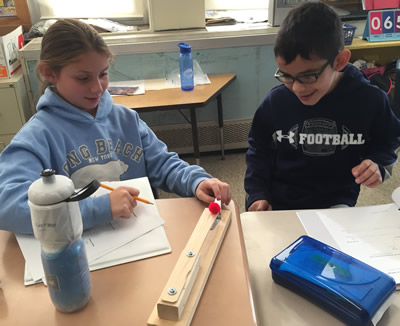Motion Energy Curriculum Unit Overview

Elementary students easily relate motion and energy; they are likely to describe another child or a car that is speeding by as having a lot of energy, and there may have been times when they themselves have been told that they have "too much energy" when they exceed the indoor speed limit at home or at school. This makes motion energy a natural starting place for a sequence of learning activities about energy for elementary students.
Does an object or person have to be speeding by to have motion energy? No. Only things that are stationary have no motion energy. The snail that is barely moving has motion energy. (Yes, because Earth is flying through space, everything on Earth has motion energy, but we will define motion as relative to a point on our planet.) We can quantify motion energy. In this unit we limit that quantification to describing objects as having no motion energy, a little motion energy, or a lot of motion energy. The faster the snail goes, the more motion energy it has.
Returning to that speeding child, can we actually see motion energy? No. Energy itself is not visible, so we depend on observable clues to inform us of the presence of energy. In the case of motion energy, we use speed as an indicator to tell us if an object has gained or lost energy.
The Energy Tracking Lens
The Energy Tracking Lens is a framework that is formally introduced to students in Motion Investigation 3B. It is a set of questions that guides students through the process of "telling the energy story," something they are asked to do throughout this unit. The Energy Tracking Lens is applicable to all systems, both simple and complex. A copy of the Energy Tracking Lens is included on the first page of each Student Notebook.
Representations
The Motion Energy Unit introduces a set of representations that become important tools for students as they reason about their ideas about the flow of energy through a system. Energy Bars, Energy Cubes, annotated drawings, and other representations also help students share their ideas with others and receive feedback.
In the Classroom
This sequence of five investigations on motion energy starts with a short video montage and discussion to elicit students’ initial ideas about energy. Students then roll small balls along a track at different speeds, an activity that supports the idea that motion energy is not just present or not, but exists along a continuum of magnitudes. In Investigation 2, students create collisions between balls on that track. In addition to being engaging, this helps develop the idea that motion energy can be transferred from one object to another, and that an energy gain in one place is always coupled with an energy loss somewhere else. The last three investigations in this unit add experiences with energy transformation. As students explore elastic objects—objects that spontaneously return to their original shape after being deformed (think rubber band, diving board)—they discover that the elastic energy of a deformed object transforms into motion energy once the deformed object is released. These key ideas about energy transfer, energy transformation, and the coupling of energy gains and losses, as well as students’ early work with representations of energy flow through a system, set the foundation for their work with energy in other contexts.